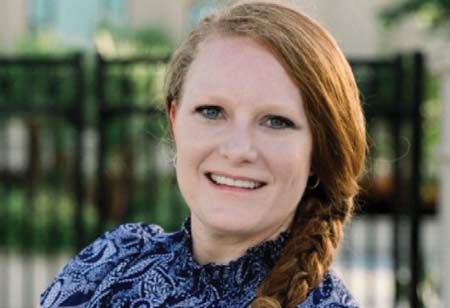

Thank you for Subscribing to Food Business Review Weekly Brief

Molly Preston, the Vice President of Procurement at Pyramid Global Hospitality, has extensive experience in food service, procurement and operations. Her passion began in college, working at a pizzeria and managing a food and beverage outlet. After graduating, she became the food and beverage director for a private student housing facility, where she developed training programs and created engaging dining experiences. She later worked in campus dining consulting and led procurement operations for a group purchasing organization. Transitioning back to operations, she oversaw corporate procurement at Benchmark Global Hospitality, now Pyramid Global Hospitality. Today, she drives strategic purchasing, optimizes supply chains and enhances guest experiences across the company’s portfolio.
Stronger Fundamentals for Organizational Success I always ensure that procurement fundamentals are in place. A solid purchasing system is essential—one that enables streamlined buying, transparent approval processes and, most importantly, transparency into procurement data across your portfolio. Once the fundamentals are in place, the focus should shift to building meaningful engagement that aligns with shared values. At Pyramid, our mission is to ‘Be the Difference’— whether as the employer of choice for our team members, the management company of choice for our owners, or by delivering exceptional guest experiences. Aligning with partners who share these values makes it easier to drive success and create lasting impact. “At every phase of the system build-out, pilot properties provided critical feedback and conducted testing. This feedback-driven approach reinforced the value of engaging a review committee and pilot group to strengthen system effectiveness” Establishing clear key performance indicators (KPI) to set goals and measure progress is also crucial. A strong group purchasing organization (GPO) partner is invaluable to achieving these goals. Leveraging hundreds of contracts, a GPO can significantly streamline procurement across all departments, especially in hospitality sectors like food and beverage. Driving Long-Term Success Through Feedback Change management plays a crucial role. Throughout my career, I have learned that transparency in goals and objectives—both with colleagues and stakeholders responsible for implementing change—is essential for success. One of the most effective ways to achieve this is through a structured feedback process, ensuring that key stakeholders from corporate operations, corporate finance, property operations and property finance contribute diverse insights. Engaging these voices early refines ideas, eliminates inefficiencies and introduces valuable perspectives that may not have been previously considered. Once goals and objectives are set, the next critical step is clear communication with field teams—particularly for those directly impacted by the initiative. I always start with a pilot phase, testing the program before full rollout, gathering feedback and making adjustments as needed. Depending on complexity, implementation is either phased or organizationwide. Post-launch, continuous input from stakeholders and end users allows for ongoing assessment, KPI tracking and refinement to ensure long-term success. Our transition to a new GPO program was a great example of this approach. A market basket analysis revealed that our new partner, Avendra, was more effective in controlling costs amid inflation. Recognizing the opportunity, we transitioned to Avendra, allowing properties to maintain many existing contracts with better pricing applied immediately while also gaining access to hundreds of additional contracts, enhanced systems and new benefits. To ensure a smooth transition, an executive committee reviewed our request for proposal (RFP) and market basket results. We then executed a phased rollout, beginning with a pilot group that provided invaluable feedback, refining the process for seamless adoption. Now, over a year post-rollout, we are seeing strong results and conducting deeper KPI analysis—both at the organizational level and for individual properties—to maximize the program’s value and savings. Another major initiative was our purchasing system overhaul. Previously, procurement was highly decentralized, with properties purchasing from multiple vendors without a standardized process. Strategically, we saw the need to consolidate purchasing habits, implement a unified system and establish clear SOPs. After evaluating multiple industry solutions, we partnered with Craftable—an established platform in the restaurant and bar industry. Given its strong applicability to hospitality, we collaborated to develop a customized, hospitality-focused procurement platform to drive efficiency. Our priority was ensuring a seamless, user-friendly experience, making the system intuitive, quick to learn and efficient—reducing the time required for purchase orders. At every phase of the system build-out, pilot properties provided critical feedback and conducted testing. Initially, we aimed for a one-month pilot phase before a full rollout, but properties took a thoughtful approach, offering detailed insights to optimize the platform for the best possible purchasing experience. As a result, we conducted a needs assessment, prioritized key refinements and extended the pilot to three months to ensure critical enhancements were made before full implementation. This feedback-driven approach reinforced the value of engaging a review committee and pilot group to strengthen system effectiveness. Now, two years after its rollout, the system has been highly successful, with a continuous feedback loop allowing for ongoing improvements. As AI technology evolves, we are actively exploring ways to integrate these advancements into our purchasing system, further streamlining operations and enhancing the user experience for our operators and buyers. Key Advice for Aspiring Leaders How do you eat an elephant? One bite at a time. It’s easy to feel overwhelmed when looking at the big picture of where you want procurement to be, especially when considering the many tasks and obstacles along the way. My advice to peers is to take it step by step—start with the basics, focus on the low-hanging fruit that delivers the biggest impact, and build from there.
However, if you would like to share the information in this article, you may use the link below:
https://www.foodbusinessrevieweurope.com/cxoinsight/molly-preston-nwid-1437.html